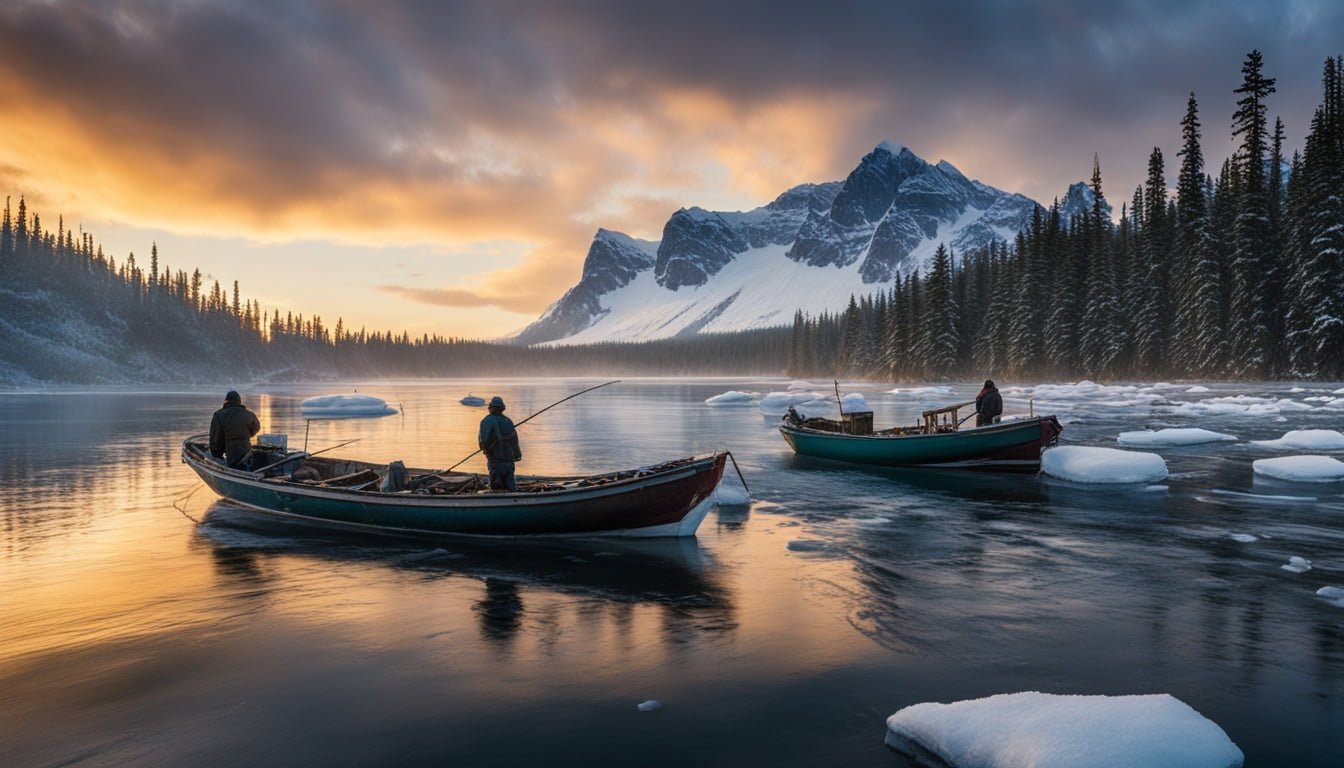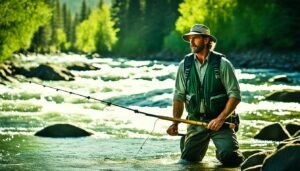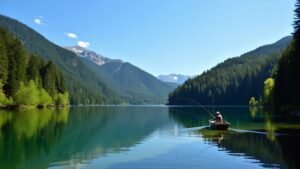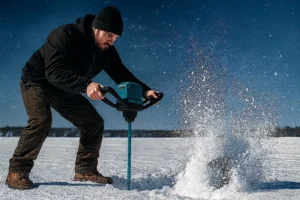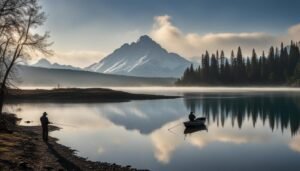Canada’s waterways hide fascinating secrets.
From Atlantic coasts to inland lakes, fishing has shaped our nation’s story. This history blends resilience, innovation, and a strong bond with nature.
How has fishing molded Canada’s identity?
How has it affected our relationship with the environment? These questions guide our exploration of Canada’s fishing heritage.
We’ll uncover tales that define our fishing legacy. We’ll explore iconic species and technological advances that transformed the industry. Join us as we trace this captivating journey through time.
Key Takeaways: History of Fishing in Canada
- Discover the deep roots of Canada’s fishing heritage, tracing its evolution from indigenous practices to modern sustainable methods.
- Explore the development of the commercial fishing industry and the emergence of iconic Canadian fish species.
- Delve into the advancements in fishing technology that have shaped the industry’s growth and efficiency.
- Understand the significance of recreational fishing and its impact on Canadian culture and the environment.
- Examine the ongoing efforts to ensure the sustainability of Canada’s fisheries through effective management policies and conservation initiatives.
Canada’s Fishing Heritage and Culture
Canada’s fishing heritage stems from Indigenous peoples and early European settlers. Indigenous communities have relied on fishing for sustenance, passing down techniques through generations. European settlers in the 16th and 17th centuries brought new fishing traditions.
Indigenous Fishing Practices
Indigenous fishing practices in Canada have evolved over centuries. They reflect diverse ecosystems and communities across the country. From West Coast salmon runs to inland lakes, Indigenous peoples developed sustainable harvesting techniques.
These practices are rooted in traditional ecological knowledge. They have shaped Canada’s fishing heritage significantly. Indigenous methods ensure responsible use of aquatic resources.
Affiliate Disclaimer: We may earn a commission from purchases made through the links on this page without any addiitonal costs for you. Thank you for supporting our website ! Appreciated 👍
Early European Settlers’ Fishing Traditions
The early European settlers brought various fishing traditions to Canada. These traditions contributed to the country’s fishing culture. Commercial whaling became important in Atlantic provinces.
The cod fishery developed into a key economic sector in Newfoundland and Labrador. These diverse fishing practices shaped Canada’s unique identity. They continue to be celebrated as part of Canada’s rich fishing heritage.
“The ocean has always been central to our way of life. Fishing is not just economic, but integral to our culture and identity.”
– Indigenous Elder
Commercial Fishing Industry Development
Canada’s commercial fishing industry has been vital to the country’s economic history. The Great Slave Lake fishery, which started in the 1940s, became a major economic driver. It provided jobs and boosted activity in the Northwest Territories.
Emergence of the Great Slave Lake Fishery
Journalists and photographers flocked to document the new northern fishery. They captured the excitement of this remote commercial fishing operation. The Great Slave Lake fishery remains crucial to Canada’s fishing heritage today.
In 2011, Canada’s Commercial Fishing Industry had impressive landings. Marine and freshwater catches totaled 876,277t, valued at $2.2 billion. Aquaculture production reached 163,036t, worth $845.6 million.
The Fishing Industry Development saw a 15% value increase in commercial marine landings. This was despite an 11% volume decrease. Increased landings of crab, shrimp, and lobster from the Atlantic coast drove this growth.
Fish processing in Canada generated $4.4 billion in revenue in 2011. This was a 9% increase compared to 2010. The industry employed many workers across different sectors.
The harvesting sector employed 49,609 fish harvesters and crew members. Aquaculture provided jobs for 3,292 workers. The fish and seafood processing industry employed 31,903 people.
“The emergence of the Great Slave Lake Fishery in the 1940s was a significant milestone in the development of Canada’s Commercial Fishing Industry.”
History of Fishing in Canada
Fishing has shaped Canada’s culture and economy for centuries. Indigenous communities and early European settlers established fishing practices that still influence the country today. From Atlantic cod to Pacific salmon, fishing has been crucial for food and jobs.
The Northwest’s fish resources were found in the 1490s. For 500 years, this area has fed Europeans. Portuguese, French, Spanish, and English fishermen first fished in Newfoundland waters.
The French fishery grew rapidly around 1575. English cod fishing expanded after the mid-16th century. Spanish fishing increased after 1545 but declined later that century.
At first, European fishermen migrated seasonally. Later, settlements in southeastern Newfoundland focused on curing cod for English trade. Portuguese fishing in Newfoundland began by 1501.
| Timeline | Key Events |
|---|---|
| 1490s | Discovery of fish resources in the Northwest Atlantic |
| 1501 | Portuguese begin fishing in Newfoundland waters |
| 1575 | French fishery in Newfoundland develops rapidly |
| Mid-16th century | English cod fishery in Newfoundland expands significantly |
| 1545-1600 | Spanish fishery in Newfoundland increases and then declines |
The fishing industry has been crucial to Canada’s growth. It has shaped the country’s culture, economy, and environment for hundreds of years. The History of Fishing in Canada and Canadian Fishing History highlight this sector’s vital role.
“Fishing has been a cornerstone of Canadian life, providing sustenance, employment, and a deep connection to the natural environment.”
Iconic Canadian Fish Species
Canada boasts a diverse array of iconic fish species. These fish have shaped the country’s history and culture. The Atlantic cod and Pacific salmon stand out as the most recognizable.
Atlantic Cod
Atlantic cod once fueled the East Coast’s fishing industry. Known for its firm, flaky white flesh, it was a dietary staple. It also served as a major export for Canada.
Overfishing has severely depleted cod populations in Atlantic Canada. Stocks have plummeted by 60% in the last two decades. Yet, the cod’s iconic status endures.
Indigenous communities have relied heavily on cod fishing. Fish made up to 80% of their traditional diet. It also provided economic stability for these communities.
Pacific Salmon
On the West Coast, Pacific salmon holds great importance. These fish migrate between the ocean and freshwater spawning grounds. They’re revered for their cultural significance and prized flavor.
Pacific salmon populations face challenges too. Chinook salmon stocks in British Columbia have decreased by 25%. This decline occurred over the past five years.
Conservation efforts aim to protect these iconic species. These include habitat restoration and catch limits. Such measures are crucial for future generations.
Canada’s fish populations face various threats. These include overfishing, habitat loss, and climate change. Sustainable fisheries management is vital for environmental well-being. It also preserves cultural heritage and economic prosperity.
| Fish Species | Population Trend | Economic Significance | Cultural Importance |
|---|---|---|---|
| Atlantic Cod | 60% decline in last 20 years | Major export and dietary staple for coastal communities | Integral to Indigenous communities’ traditional diet and livelihoods |
| Pacific Salmon | 25% decrease in Chinook stocks in the last 5 years | Significant contribution to regional economy | Deeply rooted in Indigenous traditions and culture |
Technological Advancements in Fishing
Canada’s fishing industry has transformed due to technological advancements. These innovations have boosted productivity and safety in Canadian fisheries. They include better vessels, gear, and advanced navigation systems.
Recreational fishing has seen a shift from traditional gear to modern equipment. Precision-machined reels, graphite rods, and battery-powered lures are now common. Electronic cameras and angling apps allow anglers to share experiences.
Technology in fishing has raised ethical concerns. Codes of conduct suggest limiting certain practices in small-scale lake fisheries. Social media and apps have changed how fisheries operate.
| Technological Advancement | Impact on Fishing |
|---|---|
| Precision-machined reels | Improved casting accuracy and line management for recreational anglers |
| Graphite composite rods | Enhanced sensitivity and responsiveness for detecting subtle bites |
| Battery-powered lures | Increased effectiveness in attracting fish and improving catch rates |
| Electronic trail cameras | Enabled anglers to monitor and study fish behavior in their natural habitats |
| Smartphone fishing apps | Facilitated information sharing and collaboration among anglers and fisheries managers |
Recreational fishing’s global scale requires attention from fisheries managers and policymakers. They must consider threats and opportunities from technological innovation. Canada’s fishing industry will continue to evolve with Fishing Technology and Technological Advancements in Fishing.
Recreational Fishing Evolution
Recreational fishing has shaped Canada’s rich fishing heritage. Once an elite pastime, it’s now a popular activity for many. Fly fishing leads this evolution, with a long tradition in Canada.
This sport draws countless people to Canada’s stunning rivers and streams. It has become a widely enjoyed pastime across the country.
Fly Fishing in Canadian Rivers
Fly fishing captivates anglers with its graceful casting and pursuit of elusive fish. It’s now synonymous with the Canadian outdoor experience. Anglers worldwide flock to Canada’s pristine waterways for this thrilling activity.
From British Columbia’s trout-filled waters to East Coast salmon rivers, fly fishing opportunities abound. These locations offer both excitement and serenity in nature.
Fly Fishing has greatly impacted Canada’s tourism and outdoor recreation industries. Enthusiasts boost local economies by supporting guide services, tackle shops, and lodges. This economic impact cements the sport’s place in Canada’s fishing heritage.
| Statistic | Value |
|---|---|
| Total number of fishermen and fish farmers globally | 38 million |
| People employed directly and indirectly in fisheries and aquaculture | Over 500 million |
| Per capita consumption of fish captured from wild fisheries | 14.4 kilograms |
| Per capita consumption of fish from fish farms | 7.4 kilograms |
As Recreational Fishing grows, preserving Canada’s Canadian Rivers and fish populations becomes crucial. Anglers, conservationists, and policymakers must protect these resources. This ensures future generations can enjoy fishing in the Great White North.
“Fly fishing is not just about catching fish; it’s about the entire experience of being in nature, the thrill of the hunt, and the sense of connection with the land and its wildlife.”
Sustainable Fisheries Management
Canada’s fishing industry growth has made sustainable management crucial. The country has implemented conservation efforts to promote responsible resource use. These policies aim to protect vulnerable species and balance stakeholder interests.
Conservation Efforts and Policies
The Fisheries Act is central to Canada’s sustainable fisheries management. This framework governs aquatic ecosystems and sets guidelines for monitoring and enforcement. In 2019, the act was modernized to improve its effectiveness.
The government invested $130 million annually for conservation efforts in 2018. This funding supports various programs to protect fish populations and their habitats.
Canada has taken steps to protect iconic fish species like Atlantic cod and Pacific salmon. Strict catch quotas and habitat restoration programs safeguard these valuable resources. The country also promotes sustainable aquaculture, especially in West Coast salmon farming.
Challenges persist despite these conservation efforts. The U.S. and EU have stricter seafood labeling standards. This may disadvantage Canadian exports in international markets.
However, Canada remains committed to sustainable fisheries management. Seafood exports bring in $6.6 billion annually. This industry supports the livelihoods of about 72,000 Canadians.
“Sustainable fisheries management is not just about protecting the environment, but also about balancing the interests of all stakeholders to ensure the long-term viability of this vital industry.”
Indigenous Fishing Practices
Indigenous communities in Canada have a deep bond with land and water. Their fishing practices have sustained their way of life for generations. These traditions are woven into their stories, ceremonies, and identity.
Indigenous peoples around the North Pacific have mastered sustainable salmon harvesting. They use in-river and selective fishing tools to target specific salmon runs. Wind-drying salmon and reef netting are examples of their specialized techniques.
These methods allow for unique food production while monitoring local salmon populations. Indigenous communities managed fisheries successfully for thousands of years before contact. They never gave up their right to manage fisheries for food, social, and ceremonial purposes.
- In the 1870s, when the first salmon canneries appeared on the BC coast, Indigenous peoples already had flourishing economies based on salmon.
- Indigenous communities successfully managed the fishery for thousands of years prior to contact, never giving up the right to manage the fisheries for their own benefit, including food, social, and ceremonial purposes.
- Salmon populations are enormously diverse, with many different life-history adaptations that Indigenous practices have long supported.
Traditional fishing methods show a holistic, sustainable approach. Men used small nets, underwater traps, harpoons, and spears. Women gathered clams, oysters, and seaweed. Weirs and gillnets were also common fishing tools.
The Semiahmoo people caught thousands of migrating salmon in one day using reef netting. This demonstrates the effectiveness of their techniques.
| Indigenous Fishing Group | Traditional Fishing Practices |
|---|---|
| Tlingit, Haida, Tsimshian | Gillnetting, seining |
| Bella Coola, Kwagiulth | Weirs, harpoons, spears |
| Coast Salish | Reef netting, trolling |
| Nuu-chah-nulth | Trolling, seining |
Learning from Indigenous fishing traditions is vital for Canada’s fisheries. We can revive salmon populations by working with Indigenous communities. This approach ensures climate resilience and honors the bond between people and land.
“Indigenous salmon management knowledge is rooted in more than respect for a primary food source; it is integral to creation stories, ceremonies, and cultural identity.”
Early European Settlers Fishing
European settlers arrived in Canada during the 16th and 17th centuries. They brought fishing knowledge that shaped Canada’s industry for centuries. Their diverse practices became integral to Canada’s cultural and economic fabric.
European fishing operations grew in scale and sophistication. By the 1520s, French ports sent 60 to 90 vessels yearly to fish in Newfoundland. In 1573, over 100 Spanish and French vessels fished there, compared to only four English.
The industry expanded rapidly. Catches in New England waters exceeded 100,000 tons annually by the mid-1700s. European settlers introduced distinct fishing methods and techniques.
The French favored a “wet” cure for cod. The English preferred a “dry” cure method called “saltfish”. These approaches influenced the region’s fishing culture and traditions.
Settlers also adapted to Indigenous fishing traditions. This interaction between European and Indigenous methods shaped Canada’s unique fishing heritage. It continues to define the country’s diverse fishing culture today.
| Metric | Value |
|---|---|
| Fishing vessels outfitted at Bordeaux (1545-1565) | Increased from about 20 per year to 40 |
| Fishing vessels outfitted at La Rochelle (1545-1565) | Increased from about 12 to over 40 |
| Fishing vessels outfitted at Rouen (1545-1565) | Increased from roughly 12 to over 90 |
| English fishing vessels at Newfoundland (1573) | 4 |
| Spanish and French fishing vessels at Newfoundland (1573) | Over 100 |
| Fishing boats working the Grand Banks (1620) | 300, employing around 10,000 sailors |
| Permanent residents in Newfoundland (1670s) | 1,700 |
| Transient population in Newfoundland (1670s) | 4,500 during the summer months |
European settlers’ fishing traditions greatly influenced Canada’s industry. They shaped fish types caught and processing methods. This rich heritage continues to impact Canada’s fishing industry today.
Fishing Regulations and Policies
Canada’s fisheries management involves federal and provincial policies. The Fisheries Act is the main legal framework. It promotes sustainability while balancing interests of commercial, recreational, and Indigenous fishers.
The Fisheries Act
The Fisheries Act defines fishing terms and aims to manage fisheries. It protects fish habitats and prevents pollution. The Act applies to Canadian waters and beyond for sedentary species.
It respects Indigenous peoples’ rights recognized by the Constitution Act, 1982. The Minister considers Indigenous rights and various factors when making decisions. These include sustainability, scientific info, and community knowledge.
The Act emphasizes precautionary and ecosystem approaches. It also considers sustainability and socio-economic factors in fishery management. The federal government gained authority over fisheries at Confederation in 1867.
Supreme Court decisions have recognized First Nations’ rights to fish. First Nations also reference UN Declaration articles on Indigenous Peoples’ rights. The fisheries management landscape continues to evolve.
Stakeholders work to balance diverse interests. They aim to ensure long-term sustainability of this vital resource. The complex interplay of policies shapes Canada’s fisheries regulation.
Aquaculture Industry Growth
Canada’s aquaculture industry has grown rapidly, especially in salmon farming. British Columbia’s cold, nutrient-rich waters make it ideal for these operations. The province has become a hub for this thriving sector.
Salmon Farming in British Columbia
Less than 1 percent of Canada’s suitable farming areas are used for commercial aquaculture. Despite this, the industry keeps expanding. Canada ranks around 22nd globally in seafood production.
British Columbia’s salmon farming industry is a key player in this growth. In 2019, the province led Canada in finfish production. It contributed 90,595 tonnes valued at $681.7 million.
This accounted for over 68% of Canada’s total farmed finfish production. The aquaculture industry employs over 20,000 people, with 30% being women.
In 2019, the sector produced 187,026 tonnes of seafood. This was valued at more than $1.2 billion. It boosted local economies in small and coastal communities.
| Year | Aquaculture Production (tonnes) | Value ($ million) |
|---|---|---|
| 1986 | 10,488 | $35.1 ($73 million in 2019 dollars) |
| 2019 | 187,026 | $1,200 |
The growth of Canada’s aquaculture industry, especially salmon farming in British Columbia, is crucial. It meets global seafood demand and supports local economies.
The Future of Canadian Fisheries
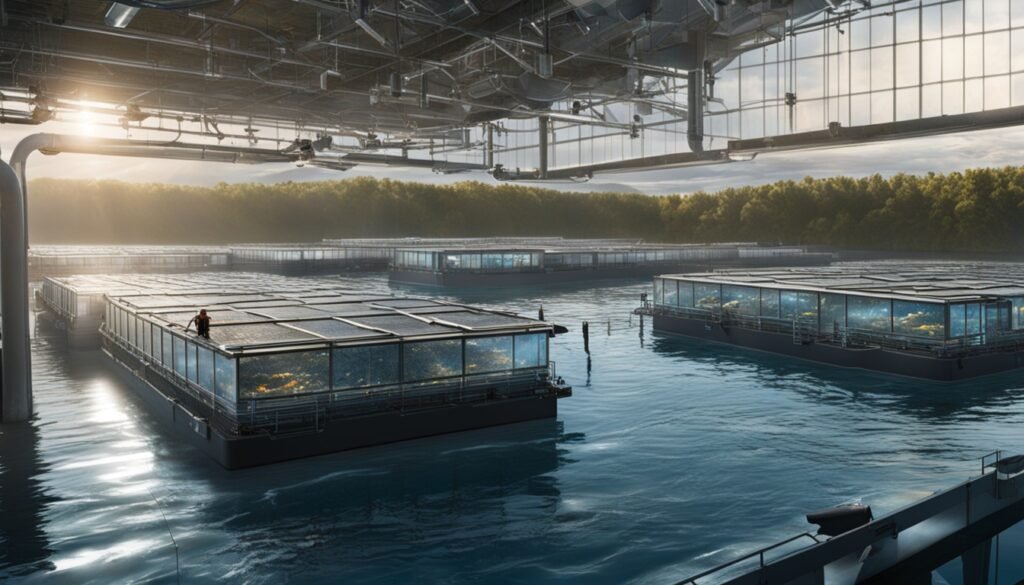
Canada’s fishing industry is evolving rapidly. The future of the country’s fisheries depends on technology, sustainability, and stakeholder balance. The Fishing Industry Outlook in Canada looks promising, with significant growth expected.
Aquaculture production is expanding in Canadian fisheries. Its value more than doubled from $392 million to $919 million between 1997 and 2010. Experts predict a 20% growth by 2027 due to high global seafood prices.
Seafood demand is rising domestically and globally. Canada’s seafood exports may exceed $8 billion by 2025. The net export value could surge by 40% by 2027.
This increased demand highlights the need for sustainable fishing. Innovative solutions are crucial to ensure the industry’s long-term viability.
- Canada exported $3.9 billion in seafood products in 2010, ranking it eighth in the world for seafood exports that year.
- Approximately 85% of Canadian seafood products are exported to other countries.
- Major export markets for Canada include the United States, the European Union, China, and Japan.
The Canadian fishing industry faces several challenges. These include rising costs, falling seafood prices, and a strong Canadian dollar affecting profits. Some marine stocks are declining despite conservation efforts.
Overcapacity in certain fisheries can harm economic performance. It also puts stress on sustainability efforts.
To address these issues, stakeholders are developing a new fisheries management system. It focuses on stability, sustainability, and transparency. This approach aims to balance various needs and invest in innovative solutions.
By doing so, Canada can secure its fishing industry’s future. It can continue leading in high-quality seafood production and export.
“The demand for seafood for food is expected to increase by 11% due to rising populations and incomes.”
Conclusion
Canada’s fishing heritage shows the importance of aquatic resources to its culture and economy. Indigenous communities, commercial fishing, and recreational angling have all shaped this rich history. The story of fishing in Canada showcases adaptation and innovation.
The industry’s future depends on balancing sustainability with diverse stakeholder interests. Resident anglers form the majority of active fishers. Non-resident anglers boost local economies significantly. These facts highlight recreational fishing’s crucial role.
The conclusion highlights the summary of fishing history in Canada. It weaves together Indigenous practices, European traditions, and technological advancements. This mix has shaped Canada’s bond with its waters.
By honoring the past and embracing sustainability, Canada can keep its fishing heritage alive. This will ensure it remains a vital part of the national identity.
FAQ
What is the history of fishing in Canada?
Fishing in Canada has deep roots. Indigenous communities and European settlers shaped early fishing practices. These practices have influenced Canada’s culture and economy for centuries.
Fishing has been vital to Canadian life. It provides food, jobs, and a connection to nature. From Atlantic cod to Pacific salmon, fishing remains essential.
What is the significance of iconic Canadian fish species?
Canada boasts diverse, iconic fish species. Atlantic cod once fueled the East Coast’s fishing industry. Pacific salmon plays a crucial role in Indigenous traditions and the West Coast economy.
How have technological advancements transformed the fishing industry in Canada?
Technology has revolutionized Canadian fishing. More efficient vessels and gear have boosted productivity. Advanced navigation and communication systems have improved safety in fisheries.
What is the role of recreational fishing in Canada’s fishing heritage?
Recreational fishing is a key part of Canada’s heritage. It evolved from an elite pastime to a popular activity. Fly fishing, in particular, has a rich tradition in Canada’s rivers and streams.
How has Canada managed its fisheries in a sustainable manner?
Canada prioritizes sustainable fishery management. The Fisheries Act promotes responsible resource use. It also protects vulnerable species and balances stakeholder interests.
What is the significance of Indigenous fishing practices in Canada?
Indigenous communities have a deep connection to water and fishing. Their practices have sustained their way of life for generations. Respecting these traditions is crucial for preserving Canada’s fishing heritage.
How has the arrival of European settlers shaped the development of Canada’s fishing industry?
European settlers brought new fishing traditions in the 16th and 17th centuries. They introduced techniques that shaped Canada’s fishing industry. These practices became integral to the country’s cultural and economic fabric.
What is the role of regulations and policies in managing Canada’s fisheries?
The Fisheries Act is Canada’s primary legal framework for fisheries. It balances various stakeholder interests. The act also promotes long-term sustainability of aquatic resources.
How has the aquaculture industry impacted Canada’s fishing heritage?
Canada’s aquaculture industry has grown significantly, especially in salmon farming. British Columbia is a hub for salmon aquaculture. This industry has both economic and environmental implications for Canada’s fishing heritage.
What are the key trends and challenges shaping the future of Canada’s fishing industry?
Technology and sustainable practices are shaping Canada’s fishing future. Balancing stakeholder needs remains a challenge. Understanding these factors is crucial for preserving Canada’s fishing legacy.
10 Weird Fish Facts Canadian Anglers Will Love in 2026 (Angler’s Edge Edition)
10 weird Canadian fish facts for 2026—plus angler tactics, regions, and ethical handling tips. Save …
Read MoreThe Beginner Fly Fishing Guide for 2026 (That Gets You to Your First Fish in 4 Weeks — Without Wasting Money)
Beginner Fly Fishing Guide for 2026: a 4-week roadmap, budget tiers, simple rigs, and first-trip che…
Read MoreRiver Fishing Techniques in 2026: The 30-Minute System to Find Fish Faster
River Fishing Techniques in 2026: a simple system to read rivers, pick winning rigs, and catch more …
Read MoreOntario Fishing & Hunting License 2026: The No-Stress Planner’s Guide (Outdoors Card, Fees, Free Fishing Dates, and Rules)
Ontario 2026 fishing & hunting license guide: Outdoors Card, fees, free-fishing dates, buying steps,…
Read MoreBest Fishing Spots in Alberta in 2026: The Ultimate Angler’s Forecast
Best Fishing Spots in Alberta in 2026, plus tactics, timing, and gear tips so you can plan safe, leg…
Read MoreThe Ultimate Guide to the Best Electric Ice Augers for Deep Canadian Snow (2026 Edition)
Discover the best electric ice augers for deep Canadian snow 2026. Expert reviews, real testing data…
Read MoreCoho Salmon Fishing: From First Bite to Full Addiction
Discover top spots and tips for Coho Salmon Fishing in Canada. Learn techniques, gear advice, and re…
Read MoreHow to Fish for Trout in a Lake (and Actually Catch More)
How to fish for trout in a lake is the question every frustrated angler asks after another long day …
Read MoreSaltwater Fishing: From First Cast to First Catch (and Beyond)
Discover the essentials of Saltwater Fishing along Canada's coastlines. Learn about gear selection, …
Read More